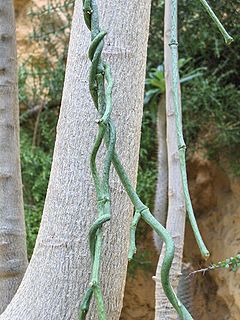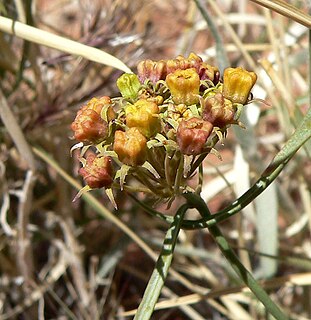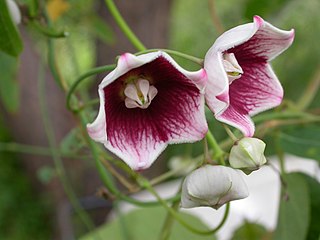
Cynanchum is a genus of about 300 species including some swallowworts, belonging to the family Apocynaceae. The taxon name comes from Greek kynos and anchein, hence the common name for several species is dog-strangling vine. Most species are non-succulent climbers or twiners. There is some evidence of toxicity.

The piebald shrew is a shrew found in the Turan Lowland east of the Caspian Sea in Iran, Turkmenistan and Uzbekistan. It grows to 2–23⁄4 inches in length, and usually hunts for insects and lizards at night. It is the only extant member of the genus Diplomesodon. In 2011, A. Cheke described a new and possibly extinct species based on a 19th-century manuscript: Diplomesodon sonnerati. It was described again in 2018 to meet certain validity requirements of the ICZN code.

Vincetoxicum rossicum is a flowering plant in the family Apocynaceae. It is a perennial herb native to southern Europe and is a highly invasive plant growing in all of the Eastern United States, in the mid west, and southern Ontario and Quebec in Canada. It has several common names including swallowwort, pale swallowwort, and dog-strangling vine. There has historically been much confusion about the genus it belongs to, with authors placing it within Vincetoxicum and others within Cynanchum, but recent molecular and chemical analyses have shown it to belong in the genus Vincetoxicum.
Metalepis is a genus of plant in family Apocynaceae first described as a genus in 1866. It is native to northern South America, Central America, Mexico, Florida, and the West Indies.
- Metalepis albifloraUrb. - Colombia, Ecuador, Fr Guiana, N Brazil, West Indies
- Metalepis cubensis(A. Rich.) Griseb. - Florida, Cuba, Belize, Veracruz in Mexico
- Metalepis gentryiMorillo - Ecuador
- Metalepis haughtii(Woodson) Morillo - Ecuador
- Metalepis peraffinis(Woodson) Morillo - S Mexico, Central America, Colombia
- Metalepis prevostiaeMorillo - French Guyana, Panama

Metastelma is a genus of plant in the family Apocynaceae first described in 1810.

Sarcostemma is a genus of flowering plants in the dogbane family, Apocynaceae, first described as a genus in 1810. The name is derived from the Greek words σαρκὸς (sarkos), meaning "flesh," and στέμμα (stemma), meaning "garland". Members of the genus are known generally as climbing milkweeds or caustic bushes. They are found across Africa and tropical Asia, in Australia, and in parts of North America. These plants are perennial flowering shrubs with trailing vines or lianas. They are often adapted to heat and/or desert conditions. Some have few or no leaves and photosynthesize in the tissues of the green stems. The soft stems are filled with a milky white latex that is poisonous and caustic in some species. The flowers have a ring of thick tissue at the base which extends into hollow spherical appendages within the flower corolla.

Vincetoxicum is a genus of plants in the family Apocynaceae. Although the species in Vincetoxicum have sometimes been included in Cynanchum, chemical and molecular evidence shows that Vincetoxicum is more closely related to Tylophora.

Trianthema is a genus of flowering plants in the ice plant family, Aizoaceae. Members of the genus are annuals or perennials generally characterized by fleshy, opposite, unequal, smooth-margined leaves, a prostrate growth form, flowers with five perianth segments subtended by a pair of bracts, and a fruit with a winged lid. The genus contains about 30 described species growing in tropical and subtropical regions, especially Australia. One common species, Trianthema portulacastrum, desert horse purslane, is frequent as a weed in agricultural areas and is widely distributed.

Cynanchum utahense is a species of flowering plant in the genus Cynanchum of the family Apocynaceae, known by the common names Utah swallow-wort and Utah vine milkweed. This relatively uncommon perennial vine is native to the Mojave Desert from California, Nevada, Utah and Arizona in the United States. This is a small vine with a highly branched, twining stem rarely exceeding a meter in length with which it physically supports itself on other shrubs and trees. It has small narrow leaves a few centimeters long. Its flowers are bright yellow to orange and grow in umbels. The fruit is a grooved follicle several centimeters long.

Cynanchum viminale is a leafless succulent plant in the family Apocynaceae. The species is native to West Africa, the Indian Ocean and Western Pacific region. The species' natural range extends from South Africa throughout much of Africa and the Middle East to India, Indochina, Southern China, Indomalaya and into Meganesia. The species is also found on several Indian Oceans islands including Mauritius, Réunion and the Seychelles.

Allium carinatum, the keeled garlic or witch's garlic, is a bulbous perennial flowering plant in the family Amaryllidaceae. It is widespread across central and southern Europe, with some populations in Asiatic Turkey. It is cultivated in many places as an ornamental and also for its potently aromatic bulbs used as a food flavoring.

Orthosia is a genus of plants in the family Apocynaceae, first described as a genus in 1844.
Jobinia is a genus of flowering plants of the family Apocynaceae first described in 1885. It is native to South America and Central America.

Decanema is a small genus in the dogbane family first described as a genus in 1838. The group is endemic to Madagascar.
- Decanema bojerianumDecne. - Madagascar
- Decanema luteifluensJum. & H.Perrier - Madagascar

Oxystelma is a genus of flowering plants of the family Apocynaceae, first described as a genus in 1810. It is native to Africa and Asia.

Raphistemma was a genus of flowering plants of the family Apocynaceae, first described as a genus in 1831, It is native to China and Southeast Asia. but now synonymous and subsumed into the genus Cynanchum.
- Raphistemma hooperianum(Blume) Decne. - Guangxi, Thailand, Vietnam
- Raphistemma pulchellum(Roxb.) Wall. - Guangxi, Thailand, India, Laos, Peninsular Malaysia, Myanmar, Nepal, Sikkim
Pentatropis is a genus of plants in the family Apocynaceae, first described as a genus in 1834. It is native to Africa and southern Asia.

Orchelimum pulchellum, the handsome meadow katydid, is a species of meadow katydid in the family Tettigoniidae. It is found in North America.
Cynanchum hooperianum is an Asian species of liana in the family Apocynaceae. Its known distribution includes: Guangxi, Indochina, Java and Sulawesi. In Vietnam it grows in the south of the country and may be called trâm hùng. Before 2016, it had been placed in the genera Oxystelma and Raphistemma.















